The Japanese Bento Box is the ultimate meal prep, consumed by millions of Japanese people every day. Today’s bento recipe is Tonkatsu Bento (Japanese pork schnitzel). It is intended to be eaten at room temperature, as everyone does in Japan.
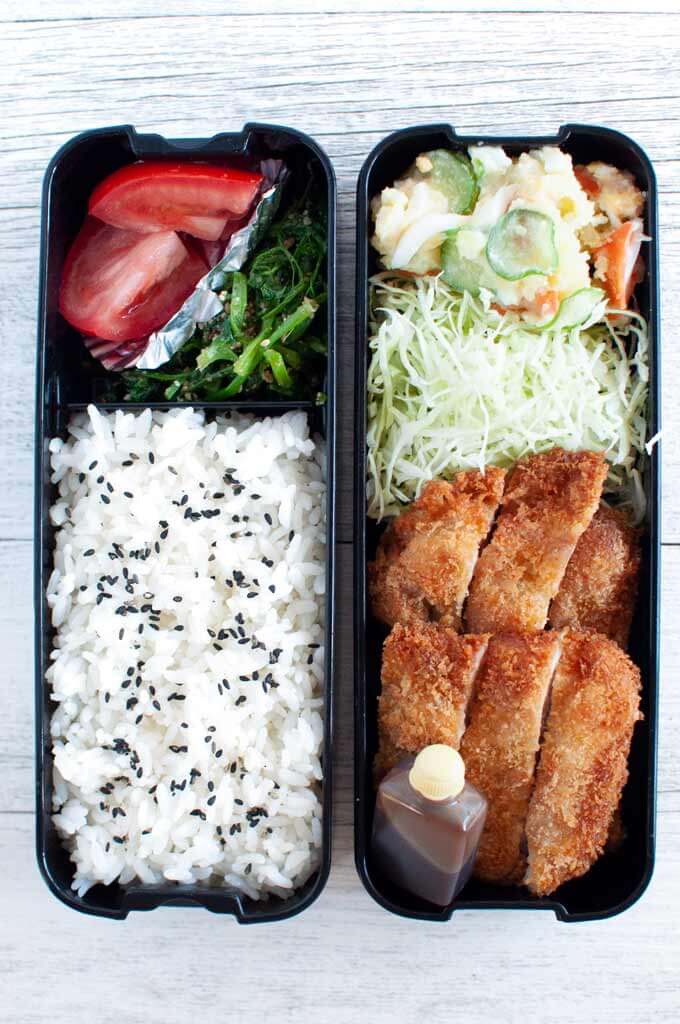
Bento (弁当) is a single portion meal packed in a container. The bento box is the container for the meal (so basically a lunch box) and it is called ‘bento-bako” (弁当箱) in Japanese. The word ‘bako’ is the same thing as ‘hako’ (箱), which also means box (it sounds easier to say ‘bako’).
Japanese people do put a lot of effort into making good looking and delicious bento. If you have travelled Japan, you probably encountered many different kinds of bento boxes sold at supermarkets, bullet train stations, department stores and convenience stores. They are made so pretty and appetising.
A home-made bento box is no exception. Small portion of various dishes are packed in a container together with rice. It is meant to contain balanced foods and whoever is making a bento box does it wholeheartedly.
Some home-made bento boxes are works of art, with cartoon characters created using the ingredients in the bento boxes. They were initially made for school kids to try to make bento more interesting and to encourage children to eat food even if they may not be fond of it.
It is called ‘kyaraben’ (キャラ弁) that is a shortened form of character bento expressed in Rōmaji. If you Google search images of ‘kyaraben’, you will be amazed at what people do to bento boxes.
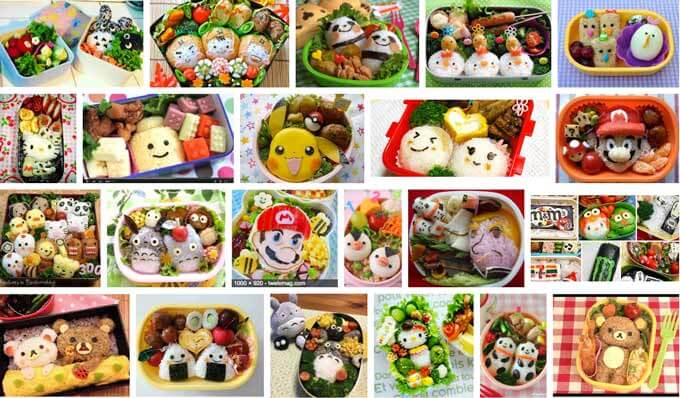
My bento box today is not a kyaraben but a standard bento with Tonkatsu as a main.
Bento is usually packed after dinner the day before it is to be eaten. Often, the ingredients are the left-overs from the meal, plus a couple of make-ahead dishes.
Tonkatsu Bento Ingredients
Ingredients for today’s Bento Box are listed below. I also added a note for variations.
- Cooked rice – this can be made ahead. Please refer to How to Cook Rice the Japanese Way. Pack cooked rice in a bento box while rice is still hot or warm as it is easier to shape it, and let it cool down before adding other ingredients.
- Tonkatsu – left over from dinner or make ahead. This can be chicken or fish cutlet instead.
- Shredded cabbage – left over from dinner or freshly made. Tonkatsu goes well with cabbage but lettuce is also good.
- Japanese Potato Salad– make ahead. I omitted sliced ham so that the potato salad can keep for a few days in the fridge.
- Snow Pea Shoots Goma-ae – make ahead. Please refer to Chrysanthemum Leaves Goma-ae to make goma-ae. I used snow pea shoots instead of chrysanthemum leaves. You could also use spinach to make goma-ae.
- Tomato wedges to add bright colour to the bento. Any other fresh veggie or even a small piece of fruit can be added here as an alternative.
- Black sesame seeds with salt sprinkled on the rice – I thought the rice area looked bare, so I added black ‘gomashio’ (胡麻塩, sesame seeds and salt). Other options include shredded roasted seaweed, furikake (rice seasoning) or umeboshi (pickled salty plum) that are mentioned in How to Cook Rice the Japanese Way.
- Tonkatsu sauce – fruity sauce perfect for tonkatsu. I buy the Bulldog bland tonkatsu sauce that I talked about in Yakisoba.
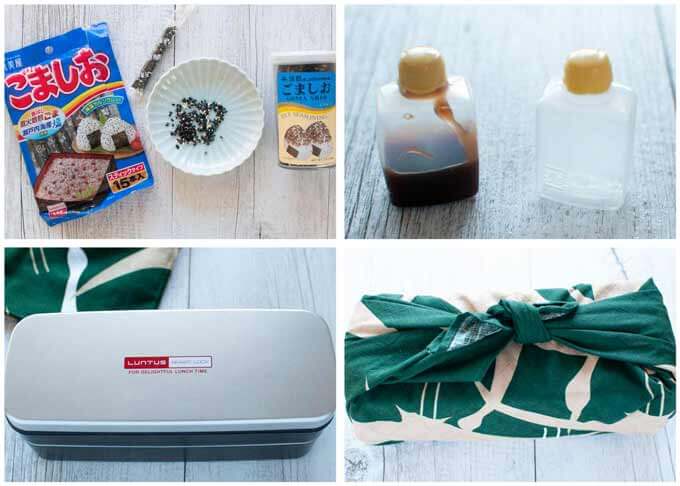
From top left clockwise: Gomashio (black sesame seeds and salt), Tonkatsu Sauce in a small plastic bottle, Bento box wrapped in a Japanese fabric wrapper, Double decker bento box.
Note 1: Gomashio (sesame seeds and salt) is sold at Japanese/Asian grocery stores. They come in either sachets or a bottle as you can see in the top left photo above.
Note 2: I had a tiny plastic sauce bottle that snuggly fit in the corner of the bento box (see the top right photo above). I bought this at a Japanese grocery store. Similar small plastic bottles can also be purchased at Daiso. But you can use a small sealed plastic container instead.
Today, I used a double decker bentō-bako (lunch box) that I bought in Japan (see the photos above). There are so many different bento boxes sold at Stores in Japan and some Japanese people have collection of bento boxes! You can of course use a normal take out plastic boxes instead.
Balance Is the Key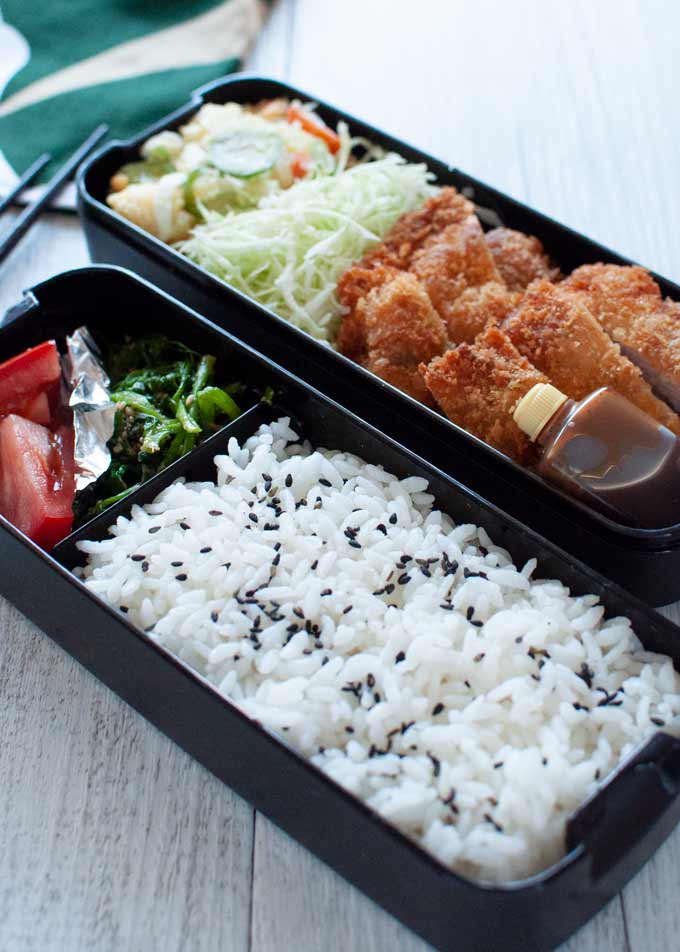
When making a bento, think about the following and imagine where to place which food in a box and how much:
- 5 colours – in my Tonkatsu Bento Box, I have white rice, green snow pea shoots & cucumber, red tomato, yellow egg yolk and brown cutlet.
- Sweetness + saltiness + sourness – in my bento box, goma-ae is sweet, gomashio is salty and potato salad is sour.
- Protein as main + sides.
- Utilise make-ahead side dishes – in my bento box, potato salad and goma-ae are make-ahead.
Traditionally, bento is meant to be eaten at room temperature without re-heating. Freshly cooked hot tonkatsu no doubt tastes wonderful. But even if tonkatsu is not hot at all, it tastes great when packed in a bento box with some other dishes.
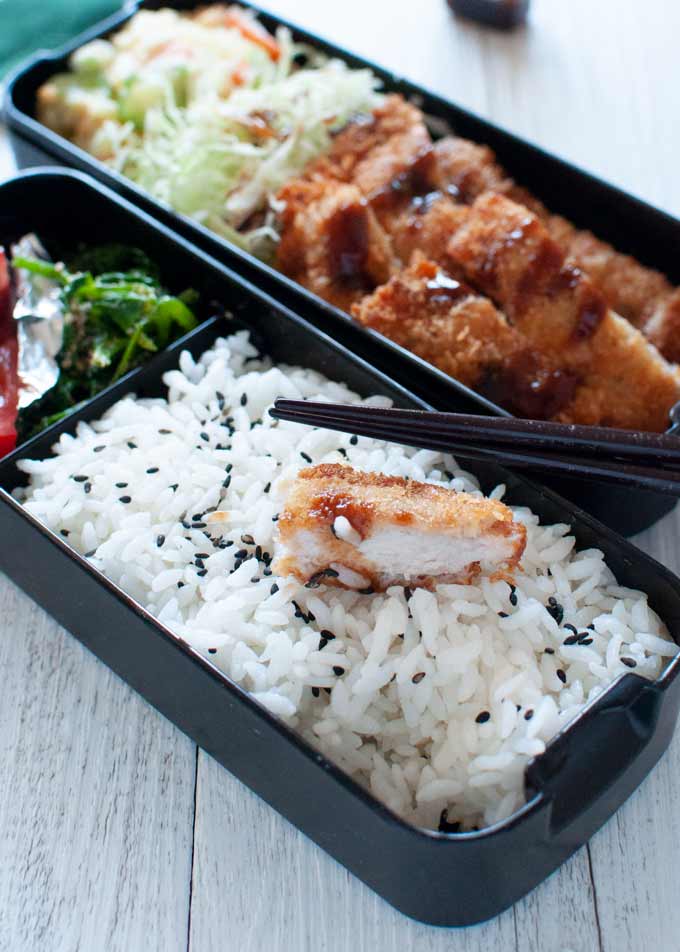
I don’t know what it is, but a bento box always gives me a smile when placed in front of me, even before opening the lid to see what’s inside. Finding out what’s inside of the bento box is almost like opening a treasure box.
Yumiko![]()
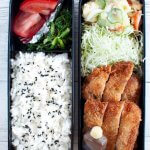
Bento Box with Tonkatsu as a main is called Tonkatsu Bento. It consists of cooked rice, tonkatsu and a small amount of a few side dishes. It is intended to be eaten at room temperature.
I have written my instructions on how to pack the box to make it look like the photo of the bento box in the post. But you don’t need to place the ingredients in the same way.
Because bento is usually made mostly from the left-over dishes or make-ahead dishes, the time indicated in this recipe only shows the time to pack the bento box.
- 1 cup cooked rice (note 1)
- 50g/1.8oz Goma-ae with snow pea shoots (note 2)
- 2 tomato wedges
- 50g/1.8oz Japanese Potato Salad
- A handful of shredded cabbage
- 100-150g / 3.5-5.3oz Tonkatsu cut into 2cm/¾" wide strips (note 3)
- Black sesame seeds with salt (optional, note 4)
- Bulldog tonkatsu sauce in a tiny bottle/jar/container (note 5)
- A bento box of your choice (I used a double decker bento box)
- A mini foil cupcake liner (note 6)
-
While the rice is still hot or warm, place the rice in the bento box and let it cool.
-
Put snow pea shoots goma-ae in a foil cupcake liner and place it next to the rice.
-
In a small space next to the cupcake liner containing goma-ae, place tomato wedges.
-
Place the potato salad at one end of the box.
-
Place shredded cabbage next to the potato salad, allowing sufficient space for the tonkatsu to fit in.
-
Place the tonkatsu pieces to fill the box.
-
If the container of tonkatsu sauce is small enough to fit in the corner of the bento box, put it in the box. Otherwise, pack it separately.
1. It is best to pack cooked rice in a bento box while hot or warm as it is easier to shape the rice into the bento box.
2. The recipe referenced here uses chrysanthemum leaves but I used snow pea shoots instead. Unlike chrysanthemum leaves, it is difficult to align the stems, so I simply spread the blanched shoots and cut to 4cm/1½” long.
3. Instead of pork, you can use chicken or fish fillet if you like.
4. I sprinkled black sesame with salt simply because the rice looked bare without something on it.
Other options include shredded roasted seaweed, furikake (rice seasoning) or umeboshi (pickled salty plum). I mentioned furikake and umeboshi in How to Cook Rice the Japanese Way.
5. Bulldog is a Japanese brand that is famous for sauces. Tonkatsu sauce is a thick fruity sauce that goes well with tonkatsu. The details and a photo of Bulldog sauces can be found in my post Yakisoba.
Sauce container - I bought a pack of small plastic sauce bottles from a Japanese grocery store. It’s like the plastic soy sauce bottle in tiny fish shape that you get at sushi roll shop. Similar tiny plastic bottles are sold at Daiso as well, if you are interested.
6. When I have two different foods that can easily integrate if placed next each other (e.g. one item is saucy), I often put one of them in a small foil cupcake liner (goma-ae in this case). Instead of a cupcake liner, you can also use a small sheet of aluminium foil to segregate two items.
Hi Yomiko
Noticed the food in bentos are meant to eat at room temperature. If I am not wrong, they would be packed in the morning and eaten at lunch, a few hours later. Is there not an issue with eating rice that has been at room temp for a few hours?
Hi Lynette, if the room is very warm or hot, it won’t be good and I’d suggest that you leave it in the fridge. Otherwise it should be OK. You can also place a small cooler/freezer pack on the bento box if you are worried. Chilled bento is not nice – rice becomes hard. You may reheat it after removing the ingredients that are not suited for reheating. If you are intending to put the bento box in the fridge until lunch time, you may pack ingredients in such way that it is easier to seperate the foods that need heating from the rest. E.g. I would put the tonkatu together with the rice in my double decker bento box (a bit tight, though), or place other dishes in okazu cups so that you can remove them easily.
Hi, I am Kyle. I have good knowledge of cooking and love to try and make different traditional dishes. That’s why I purchased a book titled Yum-Yum Bento Box and bought Japanese bento boxes from Katachiware. They provide bento boxes that are very effective to present your dish uniquely in front of others.
Hi Kyle, thanks for letting me know of Katachiware web site. Their bento boxes appear to be either very traditional (such as wooden double decker) or the kind that are served at restaurant as bento box/lunch set.
The book you mentioned seems to have lots of samples great for kids!
I wonder if you still read the replies 3 years later. This looks so nice tho but I didn’t know how to make any of the things so it’s going to be a little more complicated
Hi Emma, I get notified of a comment when placed so I can reply to all the comments I receive. If you click the link on each bento items (highlighted in red), it takes you to the recipe for the particular food. I hope you can make this bento.
Hi Yumiko, I have made this bento for lunch today, with enough leftover for our bento boxes tomorrow. The only change I made was to use firm tofu for the Katsu which I baked. It was gorgeous. Since February I have been making mainly Japanese style meals, often using meals from ‘The Recipe Tin, we are loving them. The food is delicious and we all have lost weight without really trying.
Hi Joyce, good to hear that switching to Japanese style meals contributed to the weight loss! Japanese dishes certainly contain less fat, particularly dairy products which would have contributed to it. Having several small dishes also helps as you feel like eating a lot even if total quantity is not that much.
HI Nagi thank-you for all of your pictures and recipes! I love you and them! As well as your mother’s recipes. Where can I order some of the Japanese ingredients?
Hi Marty, common Japanese ingredients are usually sold at supermarkets. Specialised ingredients are definitely sold at Japanese/Asian grocery stores and often sold only in Amazon.
Looks So delicious Yumiko san. I would love to take this Obento to school every day!
Hi Shihoko-san, thank you! Bento is really heart warming, isn’t it?
Hello Yumiko. It looks so good I think I will make it for dinner next week. It looks so pretty.
Hi Ana Maria, it’ll be fun to have a bento box for dinner.
Thank you Yumiko. Beautifully presented and explained.
Hi Tobyn, thank you!
I’ve always loved bento box lunches but have never attempted to make one. Thank you for breaking the different components down which will make it easier for me when I try to make my first one.
Hi Laurie, you are welcome and good luck with making a bento box lunch!
Thank you for the Bento photo and recipes.
How do you shred the cabbage so finely?
Janet
Hi Janet, I have a wide peeler that can be used against a quartered cabbage to shred it. If I did shred with a knife, it would be a bit thicker!